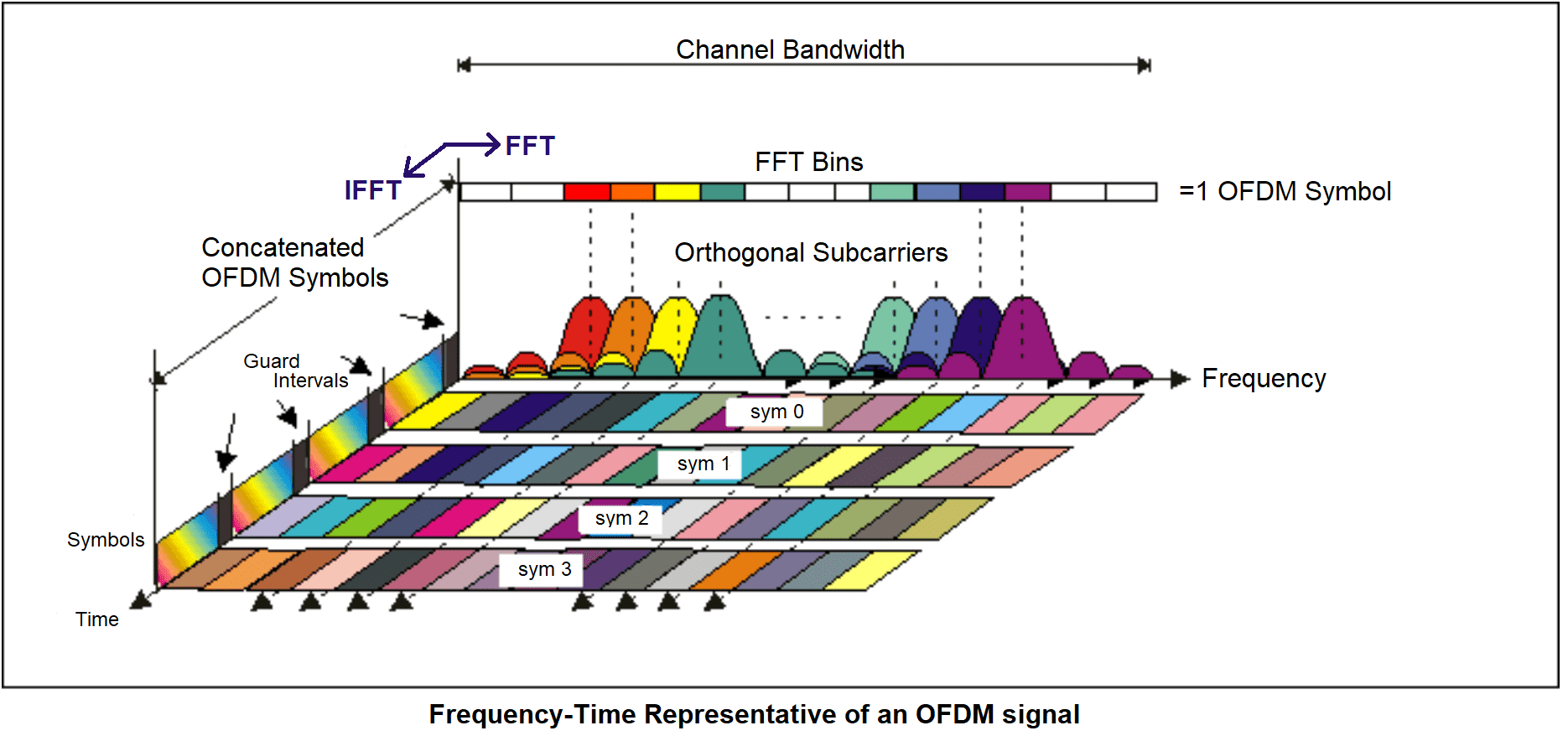About Course
OFDM for Beginners – The Arabic Version
Due to its numerous advantages, orthogonal frequency division multiplexing (OFDM) has been the most dominantly used transmission waveform in the vast majority of the currently available standards, such as WiFi, WiMax, DVB, LTE, and NB-IoT. Moreover, it should not be a surprise that the OFDM waveform (with its new parametrized waveforms to meet the diverse requirements of different emerging applications and services) has successfully maintained its dominance in 5G systems. It has been adopted due to its desirable properties and features, including higher spectral efficiency, robustness to multipath with simple equalization in the frequency domain, easy integration with MIMO systems, and multi-user diversity where time and frequency resources are flexibly scheduled among users based on their requirements and channel conditions.
Nonetheless, OFDM has several major issues and drawbacks, such as high peak-to-average power ratio (PAPR), spectral leakage, strict synchronization requirements, and frequency offset sensitivity. These issues have been heavily studied in the literature and many solutions were proposed to mitigate their side effects. In addition, it should be mentioned that in 5G new radio, different window-based time-domain filtering schemes have been proposed such as universal filtered OFDM (UF-OFDM or UFMC), filtered-OFDM (f-OFDM), time-domain windowed overlap-and-add (WOLA) based CP-OFDM, etc. Also, a flexible and effective frequency-domain filtering scheme, based on fast-convolution (FC), was proposed for filtered OFDM.
In this course called OFDM for Beginners, we explain in detail the main concept of OFDM, which is a key transmission method used in 4G (LTE), 5G, WiFi (IEEE 802.11a, g, n, ac), WiMax (IEEE 802.16), WiGig, LiFi, DVB, VADSL, and Optics. In particular, we comprehensively explain how OFDM works at the transmitter and receiver sides in wireless communication networks and show you the mathematical genius behind its implementation using Inverse Fast Fourier Transform (IFFT) at the transmitter and FFT at the receiver.
Then, we deeply explain its advantages (merits) and disadvantages (demerits) and why they exist. After that, we discuss technical solutions and methods for addressing the problems associated with OFDM-based transmission systems. Finally, we show you to simulate an OFDM system step by step using MATLAB and how to configure its parameter and debug if there are any errors in the code.
======== About the Instructor ===========
Jehad M. HAMAMREH is the Founder and Director of WISLABi/com, Editor at Researcherstore/com & RS-OJICT journal, as well as A. Professor with the Electrical and Computer Engineering Department, Antalya International (Bilim) University. He earned his Ph.D. degree in Telecommunication Engineering and Cyber-Systems from Medipol University. Previously, he worked as a Researcher at the Department of Electrical and Computer Engineering at Texas A&M University. He is the inventor of more than 20 Patents and has authored more than 90 peer-reviewed scientific papers along with several book chapters. His innovative patented works won the gold, silver, and bronze medals in numerous international invention contests and fairs.
His current research interests include Wireless Communication, Wireless Security, Wireless Sensing, O-RAN, 5G/6G, IoT, AI/ML, wireless physical and MAC layers security, orthogonal frequency-division multiplexing (OFDM), multiple-input multiple-output systems (MIMO), advanced waveforms design, multidimensional modulation techniques, and orthogonal/non-orthogonal multiple access schemes for future wireless systems. He is a regular investigator and a referee for various scientific journals as well as a TPC member for several international conferences. He is an Editor at RS-OJICT and Frontiers in Communications and Networks.
Key Research Topics: Wireless Communication, Wireless Security, Wireless Sensing, Open RAN, 5G/6G, IoT-AI
What you’ll learn
- OFDM Transmitter design
- OFDM Receiver design
- OFDM Pros. and Cons.
- OFDM Simulations
- OFDM PAPR Problem and Solution
- OFDM OOBE Problem and Solution
Are there any course requirements or prerequisites?
- Desire to learn the subject of OFDM
- Basic knowledge of signals and telecommunications systems
Who this course is for:
- Electronic engineers
- Computer Engineers
- Electrical engineers
- Systems Developers
- Anyone interested in OFDM
=========================================
In the recent past, high data rate wireless communications are often considered synonymous with an Orthogonal Frequency Division Multiplexing (OFDM) system. Orthogonal frequency-division multiplexing is the technology behind many high-speed systems such as WiFi (IEEE 802.11a, g, n, ac), WiMAX (IEEE 802.16), and 4G mobile communications (LTE). A close cousin, Discrete Multi-tone (DMT), is used in ADSL and powerline communication systems. Therefore, it seems imperative to have a signal-level understanding of how orthogonal frequency-division multiplexing works. We start with a short introduction to a wireless channel.
OFDM is a special case of multi-carrier communication as opposed to a conventional single-carrier system. Orthogonal Frequency Division Multiplexing (OFDM) is a type of digital modulation used for data transmission over multiple channels. It is a type of digitally modulated signal that is transmitted on multiple orthogonal channels. The advantages of OFDM are as follows:
1. OFDM is a very robust modulation technique since it is able to withstand frequency-selective fading, which is caused by multi-path propagation. This makes OFDM well-suited for applications such as wireless local area networks (WLANs) where the transmitted signal can be subject to interference and fading.
2. OFDM is very efficient in terms of bandwidth usage since it is able to carry a large amount of information over a given bandwidth. This makes OFDM suitable for applications such as digital video broadcasting (DVB) and digital audio broadcasting (DAB) which require large amounts of data to be transmitted.
3. OFDM is a very flexible modulation technique since it can be adapted to different transmission channels. This makes OFDM suitable for applications such as wireless personal area networks (WPANs) where the transmission channel can vary significantly. 4. OFDM is relatively easy to implement since it does not require complex adaptive equalizers or complex coding techniques.
This makes OFDM suitable for applications such as digital television (DTV) where the transmitter and receiver are not able to adjust to changes in the transmission channel. Despite its many advantages, there are some disadvantages associated with OFDM. These include:
1. OFDM requires a large number of subcarriers which leads to a high peak-to-average power ratio (PAPR). This makes OFDM unsuitable for applications such as mobile radio where the transmitted signal needs to be as efficient as possible.
2. OFDM is susceptible to interference since it relies on multiple orthogonal channels. This makes OFDM less suitable for applications such as wireless local area networks (WLANs) where the transmitted signal can be subject to interference from other devices.
3. OFDM requires a large amount of processing power which can limit its use in applications such as digital television (DTV) where the receiver must be low-cost and power-efficient.
4. OFDM is more complex than other modulation techniques which can make it difficult to implement and maintain. This can be a problem for applications such as digital audio broadcasting (DAB) where the transmitter and receiver need to be reliable and easy to use.
In conclusion, OFDM is a very robust and efficient modulation technique which has a number of advantages for applications such as wireless local area networks (WLANs) and digital television (DTV). However, it also has some disadvantages such as a high peak-to-average power ratio (PAPR) and susceptibility to interference. Therefore, it is important to consider the application when selecting a modulation technique to ensure that it is suitable for the particular use case. is based are so simple that almost everyone in the wireless community is a technical expert in this subject. However, I have always felt an absence of a really simple guide on how orthogonal frequency-division multiplexing works which can prove useful for technical persons not wanting to deal with too many technicalities, such as DSP experts outside communications, computer programmers, ham radio enthusiasts, and the likes. So here it is.

Course Content
OFDM : Transmission Technique
-
OFDM as a key transmission method used in 4G, 5G, WiFi, WiMax, WiGig, LiFi, DVB, VADSL, Optics (Part-1)
02:22:29 -
OFDM as a key transmission method used in 4G, 5G, WiFi, WiGig, LiFi, DVB, VDSL, Optics (Part-2)
02:12:16 -
OFDM as a key transmission method used in 4G, 5G, WiFi, WiGig, LiFi, DVB, VDSL, Optics (Part-3)
01:52:37

